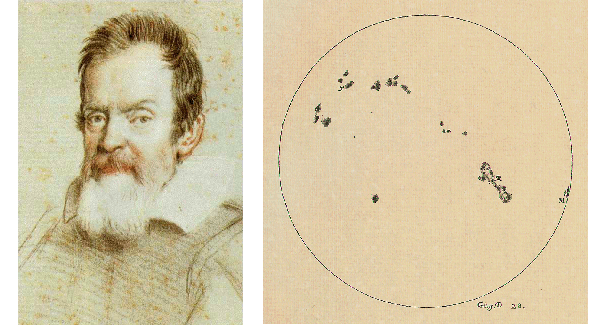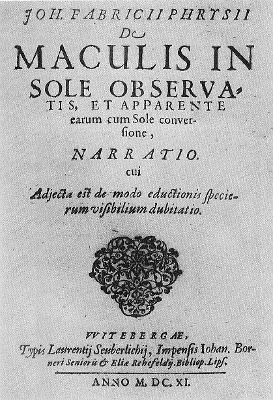
Four Hundred Years of Sunspots
March 22, 2011 I wrote about sunspots in a previous article (Stuck in the Solar Minimum, June 16, 2010). Many people, myself included, associate Galileo with the discovery of sunspots. Galileo didn't invent the telescope, but he perfected it enough to make the first detailed astronomical observations of the Moon, Sun and planets. It was he who discovered the four largest moons of Jupiter (Io, Europa, Ganymede, and Callisto) and Saturn's rings, although he mistook the rings for a disappearing pair of moons. Surprisingly, Galileo wasn't the discoverer of record of sunspots. Galileo made his sunspot observations in 1612, and he published these in 1613 in his "Istoria e Dimostrazioni Intorno Alle Macchie Solari e Loro Accidenti" (History and Demonstrations Concerning Sunspots and their Properties).[1] Johannes Kepler had seen a sunspot in 1607, but Kepler's forte was planets, so he mistook it for the planet Mercury. The first telescopic observations of sunspots were made by Thomas Harriot in December 1610. Harriot never published his observations, but his drawings are still extant.[2] The discovery of sunspots, as asserted by the scientific principle of first publication, was made in 1611 by Johannes Fabricius (1587-1616), also known as Johann Goldsmid, a Frisian-German astronomer.[3] Sketch of Galileo, after Ottavio Leoni (1578-1630); and Galileo's drawing of sunspots that appeared on June 28, 1613 (from the collection of Owen Gingerich)
Johannes Fabricius first observed a sunspot on February 27, 1611. Fabricius, in the company of his father, began his observations with a telescope. Johannes' father, David Fabricius, was a Lutheran pastor and astrologer who discovered the variability of the star, Mira, in 1596.[2] Telescopic observation of the sun was found to be dangerous, even when their observations were of the rising and setting sun, as he documented.[3,4] They switched to a camera obscura, which must have given excellent results, owing to the intensity of sunlight. In this way they could easily see how the spots moved with apparent rotation of the sun.[3]
Johannes Fabricius published their observations in a twenty-two page pamphlet, dated June 13, 1611. It was entitled, "de Maculis in Sole observatis et apparente earum cum Soleconversione, Narratio" (Account of Spots observed on the Sun and of their apparent rotation with the Sun). Copies were sold at the Frankfurt book fair that same year.[4] The title page proudly states his Frisian nationality.
This is not a scientific paper, in the true physics style of Galileo, and that may be the reason for Galileo's observations' usurping a virtual priority. Although the method of observation was presented, there were no dates and times of the observations, and no drawings.[4] I guess woodcuts were too expensive for Fabricius. He did write his opinion that the Sun rotated.[4]
Sketch of Galileo, after Ottavio Leoni (1578-1630); and Galileo's drawing of sunspots that appeared on June 28, 1613 (from the collection of Owen Gingerich)
Johannes Fabricius first observed a sunspot on February 27, 1611. Fabricius, in the company of his father, began his observations with a telescope. Johannes' father, David Fabricius, was a Lutheran pastor and astrologer who discovered the variability of the star, Mira, in 1596.[2] Telescopic observation of the sun was found to be dangerous, even when their observations were of the rising and setting sun, as he documented.[3,4] They switched to a camera obscura, which must have given excellent results, owing to the intensity of sunlight. In this way they could easily see how the spots moved with apparent rotation of the sun.[3]
Johannes Fabricius published their observations in a twenty-two page pamphlet, dated June 13, 1611. It was entitled, "de Maculis in Sole observatis et apparente earum cum Soleconversione, Narratio" (Account of Spots observed on the Sun and of their apparent rotation with the Sun). Copies were sold at the Frankfurt book fair that same year.[4] The title page proudly states his Frisian nationality.
This is not a scientific paper, in the true physics style of Galileo, and that may be the reason for Galileo's observations' usurping a virtual priority. Although the method of observation was presented, there were no dates and times of the observations, and no drawings.[4] I guess woodcuts were too expensive for Fabricius. He did write his opinion that the Sun rotated.[4]
 | Frontpiece of "de Maculis in Sole observatis et apparente earum cum Soleconversione, Narratio" ("Account of Spots observed on the Sun and of their apparent rotation with the Sun") by Johannes Fabricius (Figure from Wikimedia Commons). |
"There were probably heavy arguments about seeing these sunspots... Galileo had just spotted the moons around Jupiter in 1610, and this was already a sin for father Fabricius, who believed that everything went around Earth and not other planets. So he was probably very suspicious about what his son did."Lord Kelvin, who is famous for so many things, was especially wrong when it came to the sun. As I wrote in a previous article (Lightning Generated Antimatter, February 17, 2011), he underestimated the age of the sun by a huge amount. His error can be excused in this case, since nuclear fusion had yet to be discovered, and everyone thought that the Sun's heat came from gravitational contraction or an infall of meteors. Kelvin's other error was his disbelief that sunspots are a magnetic disturbance, although geomagnetic storms and sunspot activity were found to be correlated. George Ellery Hale eventually demonstrated the Zeeman effect (a magnetic effect) in a sunspot spectrum, giving an unequivocal proof of sunspot magnetism (at least as far as scientific proof goes).[6] I measured the Zeeman effect in an undergraduate physics experiment. This was difficult to do, since chemical photography was involved. Nowadays, students use digital imaging. Easier, yes; better, maybe not. Sometimes you need to feel the warm experiment against your skin to get the full effect.
References:
- Galileo's Sunspot Drawings at The Galileo Project, Rice University
- Thomas Harriot web page on Wikipedia
- Johann Fabricius Biography, High Altitude Observatory, University Corporation for Atmospheric Research, The National Center for Atmospheric Research.
- If any of you have the opportunity to witness an eclipse of the sun, be warned! Sun glasses, smoked glass and other filters are not sufficient eye protection. Use a pinhole camera to view the projected image, much as Fabricius used the similar camera obscura.
- David and Johannes Fabricius web page at The Galileo Project, Rice University
- Karen C. Fox, "Celebrating 400 Years of Sunspot Observations," NASA Goddard Space Flight Center Press Release, March 9, 2011.
- Thomas Harriot web page on Wikipedia